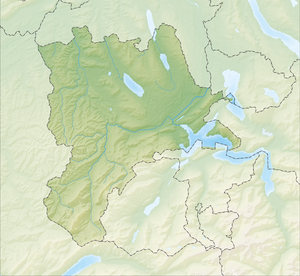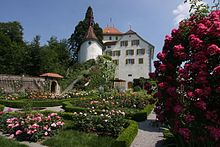Heidegg Castle
| Heidegg Castle | ||
|---|---|---|
| Creation time : | 12./13. century | |
| Standing position : | Seat of the Lords of Heidegg, then the country seat of the Lucerne patriciate, today a museum | |
| Place: | Gelfingen , municipality of Hitzkirch, Seetal, canton of Lucerne | |
| Geographical location | 47 ° 13 '0.3 " N , 8 ° 16' 22.9" E | |
| Height: | 556 m above sea level M. | |
|
|
||
The Heidegg Castle is located in Gelfingen in Lucerne Valley in Switzerland, high above Lake Baldegg, amid a largely preserved parks and cultural landscape of national importance.
history
The first surviving document that mentions the lords of Heidegg dates from 1185. As ministerials , the Heideggers were in the service of the sovereigns in the Seetal , probably initially the Counts of Lenzburg , then the Kyburgs and the Habsburgs . Castle and rule emerged in the wake of the wave of cities and castle founding in the 12th and 13th centuries. Century. This also included the Seetal, which for a short time in the 13th century rose to become the best interregional land connection between Gotthard, Lucerne and Basel. The Heidegg lordship comprised manorial rights, the lower jurisdiction over Gelfingen and Altwis, the Vogtei over most of the Baldeggersee, vines and forests. In 1431/37 the new owner family Büsinger acquired the Lieli estate with the Twingen Lieli, Sulz and Mosen.
From 1482/83, influential city council families from Lucerne replaced the noble owners. From 1678, Johann Heinrich Franz Pfyffer von Altishofen expanded the largely medieval residential tower into a baroque palace. The family branch was now called Pfyffer von Heidegg . In 1700 the city of Lucerne acquired the castle and the manor and completed the interior work. In 1798 the rule of law ended. Heidegg became a state domain of the canton of Baden and from 1803 to 1848 of the canton of Lucerne, which auctioned them to the liberal Gelfingen farmer Joseph Heggli after the lost Sonderbund war.
In 1875, the wealthy Lucernian-American couple Ludwig and Caroline Pfyffer von Heidegg-Slidell bought the castle back, provided the exterior of the complex with battlements and portals in the romantic sense of a castle, laid out a castle park with a chestnut avenue and made the castle tower habitable again in 1912. In 1950 the last descendants, the childless widows Mathilde von Glutz and Marie-Louise de Chambrier, donated the castle to the Canton of Lucerne , which made it accessible to the public. Since then, the company and the museum have been run by the Pro Heidegg Association.
At the beginning of the 1950s , the rose garden laid out by Gottfried Boesch at the suggestion of the German Chancellor Konrad Adenauer , the castle hill again planted with vines, on which Lucerne's state wine grew, and the newly founded Swiss Hunting Museum at Heidegg Castle helped achieve a supraregional appeal. From 1995 to 1998 the canton of Lucerne subjected the castle to a complete renovation.
Castle owner
1185 Lords of Heidegg, 1421/29 Büsinger, 1482/83 Hasfurter, 1522/28 Tammann, 1561 Kündig, 1618 Fleckenstein, 1664/65 Pfyffer von Heidegg, 1700 Lucerne, 1798 Canton Baden, 1803 Canton Lucerne, 1849 Heggli, 1875 Pfyffer von Heidegg, 1950 Canton of Lucerne
Building history
In today's castle tower is the oldest known residential building on Lucerne soil, a stone house from 1192 (tree ring dating from 2013). It was expanded and raised to a Romanesque residential tower in 1229/30 and 1236/37. In the 18th century it was converted into an occasionally inhabited country residence. From 1678 onwards, it was expanded into a baroque palace, initially with four corner oriels, which were soon removed. In 1688/98 the castle tower with its hipped roof and uniform yellow plaster received its characteristic shape as a landmark of the Seetal. The St. The chapel dedicated to Karl Borromeo dates from the 16th / 17th centuries. Century, the house with vaulted cellar and grain chute from 1704, the farm from the 18th – 20th centuries. Century.
sightseeing
The museum in the castle tower is dedicated to the 800-year history of Heidegg and its region. The permanent exhibition and residential museum of the Pfyffer von Heidegg family are enriched with special exhibitions and adventure offers. The rose garden, which was renewed in 2004/05, the Sieben-Brüggli-Weg through the romantic Burgtobel and the avenue with rest areas and playgrounds make Heidegg Castle and Park a popular excursion and local recreation area. Numerous halls and rooms can be used or rented for events.
Picture gallery
literature
- Peter Eggenberger, Peter Niederhäuser, Dieter Ruckstuhl: From the castle to the country seat: Heidegg Castle, 1192-1700. Series: Schloss Heidegg history 3. Chronos Verlag, Zurich 2018. ISBN 978-3-0340-1448-9 .
- Josef Egli: center of power - village theater - fairytale castle. From the history of Heidegg Castle from 1775 to 1950. Series: Heidegg Castle History 2, Gelfingen 2009, ISBN 978-3-9523031-3-9 .
- Dieter Ruckstuhl u. a .: Romantic castle dreams. Stately garden culture at Heidegg Castle in the 19th and 20th centuries. Series: Schloss Heidegg Geschichte 1, Gelfingen 2006, ISBN 3-9523031-1-9 .
- Dieter Ruckstuhl: Heidegg Castle. (Swiss Art Guide, No. 691, series 70). Ed. Society for Swiss Art History GSK. Bern 2001, ISBN 3-85782-691-6 .
- Adolf Reinle: The Art Monuments of the Canton of Lucerne, Volume VI, The Office Hochdorf. Birkhäuser Verlag, Basel 1963, pages 82-91.
- Gottfried Boesch: Heidegg Castle. History of the castle and its inhabitants. Gelfingen 1951.
Web links
- Heidegg Castle website
- Castle world: Heidegg Castle
- Waltraud Hörsch: Heidegg. In: Historical Lexicon of Switzerland .











